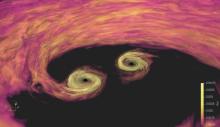
Description
Supermassive black hole mergers are one of the most dramatic phenomena
in the Universe. For a few hours, they can emit as much power in gravitational waves as all the
stars in the Universe produce in light. Moreover, they are an important element in determining
the mass distribution of the entire population of supermassive black holes. However, none has
yet been caught in the act, in large part because they are rare, and no one knows what sort of
light they should emit along with the gravitational waves. It is the goal of this project to
combine astrophysical knowledge about the environments of supermassive black hole binaries
with detailed physical simulation of gas flows in the immediate neighborhoods of these binaries
and explicit computation of the time-dependent spacetimes in which the gas is placed in order
to predict the light observers should search for in order to find examples.
Intellectual Merit: Over the past ten years, our group has built the
knowledge base and computational methods needed to reach this goal, and we are now ready
to take the final steps. We have built a ``multipatch" simulation infrastructure to
permit simulation of gas accretion in the approach to merger; to avoid prohibitive
computational cost, it is necessary both to compute the changing spacetime by means
of post-Newtonian and other sorts of perturbative approximations and to create simulation
tools permitting separate treatment of subregions within the binary environment. We
have also built post-processing tools to transform fluid simulation data into
predictions of photon radiation, accounting for the principal radiation mechanisms,
opacities, and photon propagation through dynamical spacetimes. In the work we proposed,
we will first study the immediately pre-merger state with a view both to understand
its specific physical mechanisms and to prepare realistic initial data for a separation
calculation of events during the merger itself. The second step is then to take that
data and compute how matter behaves during the merger proper and the subsequent relaxation
phase. We will use our post-processing machinery to predict EM spectra and lightcurves
throughout all these phases.
Broader Impacts: Because this program fits so squarely within the NSF ``Big Idea"
Windows on the Universe, our research will contribute to one of the major goals of the agency.
In particular, it strengthens the work of the LIGO, NanoGrav, and LSST projects. In addition,
the two postdocs participating in the project will learn both about the techniques of this
new field and about very large-scale computation, strengthening the US technical workforce.
Ancillary efforts by the PIs enhance the teaching program at each of their universities.
Both PIs also contribute to public outreach through a variety of channels.